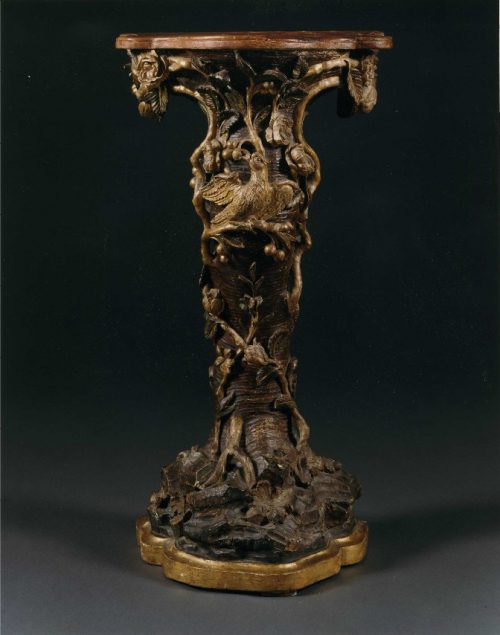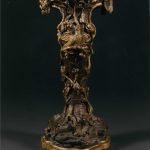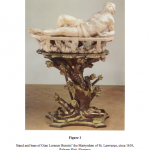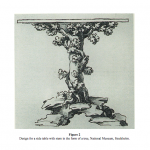9233 A VERY RARE PAINTED AND GILDED TREE PEDESTAL IN THE MANNER OF GIAN LORENZO BERNINI Probably Rome. 17th Century. Measurements: Height: 35 1/4″ (89.5 cm) Width: 19″ (48.5 cm) Depth: 18″ (46 cm)

-
Figure 1
-
Figure 2
Research
Of carved limewood with original painted and gilded decoration. The shaped top, with molded edge raised on a spreading stem in the form of a tree trunk, with entwined foliage, flowers and berries with a bird set to the front, the stem above a rock-work plinth raised on an irregular shaped base. Restored plinth.
Provenance:
Beatrice Vivarelli Colonna, Sydney, Australia
The present pedestal is conceived in the manner of the great genius of the Roman baroque, Gian Lorenzo Bernini (1598 -1680).
The sculptural treatment of furniture, with elements composed of the natural forms of trees and rocks, often with decoration in the form of plants, was a characteristic that developed in Roman design in the first part of the seventeenth century.
The principle of the base and stem of the pedestal taking the form of a trunk of a tree growing from a mound of rocks, is most famously realized in the stand and base of Bernini’s sculpture the Martyrdom of St Lawrence of circa 1617, today in the Palazzo Pitti in Florence. In that work the curving form of the tree stem issues gilded flaming foliate decoration that rises to support the form of the reclining St. Lawrence (figure 1).
An anonymous seventeenth-century design in the collection of the Stockholm Nationalmuseum is close to the manner of the present pedestal in its form (figure 2). Although it lacks the finely carved enlivening form of the bird to the front of the stem found in the present piece, the drawing depicts a table set on a rocky base with a single stem in the form of a tree trunk around which a plant is entwined (figure 2). The rectangular top is then supported on a profusion of branches and leaves.
A drawing by Bernini in the Museum der Bildenden Künste, Leipzig, shows the sculptor addressing the composition of a base conceived in this naturalistic manner. In a series of rapid pen sketches for the Fountain of the Four Rivers, Bernini transforms the geometric blocks of supporting stone into the irregular form of the rocky outcrops of the plinth.
The Colonna family is an Italian noble family, who reached their height of power in medieval and Renaissance Rome. Their family residence, Palazzo Colonna, remains one of the greatest of the Roman palaces, serving as a reminder of the power and wealth of the old papal nobility, and representing one of the finest surviving baroque interiors in the city.



Comments are closed.